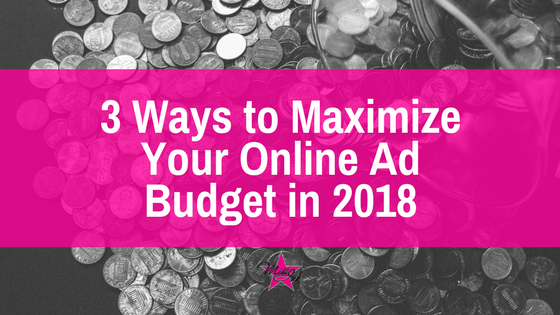With the recent major changes started by Facebook in the way that content is shown on social media channels, moving away from branded content and more toward friends and family posts, brands and companies have to shift their focus with their online marketing strategy. More and more social channels are shifting from organic branded posts and moving toward a pay-to-play model.
It is projected that in 2018, the average firm will allocate 41 percent of its marketing budget to online marketing. Additionally, 25 percent of that total online spending will be used on social media alone. This means that marketers and advertisers should be focusing heavily on an online marketing budget, geared toward influencers, ads, and programmatic marketing.
Here are three ways that you can maximize your online budget in the present and future models of social media and advertising online.
1. Macro Influencers vs. Micro Influencers
Influencers can be categorized as either micro or macro. You may associate macro influencers with celebrity-status individuals. These are people who have hundreds of thousands or even millions of followers online and who are often considered a household name. Macro influencers can be very expensive to work with, and their audience engagement may not be as high or as targeted as you need for your brand.
Micro influencers are people with 1,000 to 10,000 followers who have high-engagement on their social media channels. These people are often local or industry focused, and have a following of people who trust their authenticity with brands. Micro influencers are often more accessible and more affordable to work with when it comes to dedicating dollars to promote your brand or product. Research is key in identifying the right influencer, as you want to make sure your target customer is seeing your brand being used by someone they respect.
The average cost for an Instagram post with a micro influencer is about $180-$200, but the exposure for your brand may be worth the investment. Many of these types of influencers also want to establish partnerships with brands, and your continued relationship may end up bringing you a high return on investment.
2. Social Media Ads
As we mentioned before, Facebook, and other social media channels, have made changes recently to focus on friends and family posts while requiring businesses and brands to consider paid boosted posts or ads in order to reach an audience. While this might require advertisers to spend more up front, the benefits to social media ads, especially on sites like Facebook, is that they can be created to be highly targeted to the exact audience companies want to reach.
Industry best practices stipulate that it’s best to plan on a minimum of $1,000 a month on social media advertising, although we’ve seen our clients garner significant traction with as little as $250-$500 a month. For example, on Facebook, you can pay as little as $5 to boost a post, creating a targeted audience outside of your followers who may find your information relevant. On Facebook, Twitter, and Instagram, you can create ads that are specifically targeted to reach the people who find the most value in your products or service. The one thing to keep in mind with your social media ad budget is that the more money you spend, the more people you’ll reach. With organic reach, it may be more difficult to know who is seeing your ad and who has not, but by purchasing ad space online, you can ensure that potential customers are seeing your marketing efforts.
3. Programmatic Marketing
Programmatic Marketing is the future of online marketing. Google is projecting that 60 percent of digital ad budgets will be spent on this type of marketing this next year, and the Magna Global Programmatic Intelligence report says that by 2019, Programmatic Marketing will be 50 percent of all advertising.
Smart Insights defines Programmatic Marketing as an “automated bidding on advertising inventory in real time, for the opportunity to show an ad to a specific customer, in a specific context.” In other words, when a customer visits a website, there is an online auction between advertisers to decide whose ad will appear on that site based on the customer’s data. The auction happens in milliseconds because the bids have been pre-determined and the resulting auction process is automated. The benefit to advertisers is that there is no pre-negotiation of price, and ads are being shown to only relevant potential customers. (
https://boxmining.com) Therefore, advertisers are only paying for relevant impressions and not just blind impressions on a page.
There are many ways to spend your online marketing dollars, but it’s important for brands and marketers to have a strategy in place to get the most for their money. If you need help with your online marketing strategy,
contact us at Miss Ink. We can get you started with a paid and organic content and social media strategy to bring your brand maximum exposure and engagement.
References:
Rendler-Kaplan, L. (2017, October 20). Micro-Influencers, Maximum Benefit. Retrieved February 16, 2018, from https://www.socialmediatoday.com/news/micro-influencers-maximum-benefit/507629/
Joseph, F. 1., Joseph, J. 1., Joseph, J. 2., Joseph, F. 1., Liffreing, F. 1., Liffreing, F. 1., . . . Weiss, F. 1. (2018, February 01). Advertisers are using Facebook’s news-feed revamp to get bigger media budgets. Retrieved February 16, 2018, from https://digiday.com/marketing/advertisers-using-facebooks-news-feed-revamp-get-bigger-media-budgets/
O’Bannon, E. (n.d.). Social Media Ad Budget: Best Practices. Retrieved February 16, 2018, from https://www.meetcortex.com/blog/social-media-marketing/social-media-ads-best-practices
How Much Budget for Online Marketing. (n.d.). Retrieved February 16, 2018, from https://www.webstrategiesinc.com/blog/how-much-budget-for-online-marketing-in-2014
What is Programmatic Marketing? (2016, March 01). Retrieved February 16, 2018, from https://www.smartinsights.com/internet-advertising/internet-advertising-targeting/what-is-programmatic-marketing/


